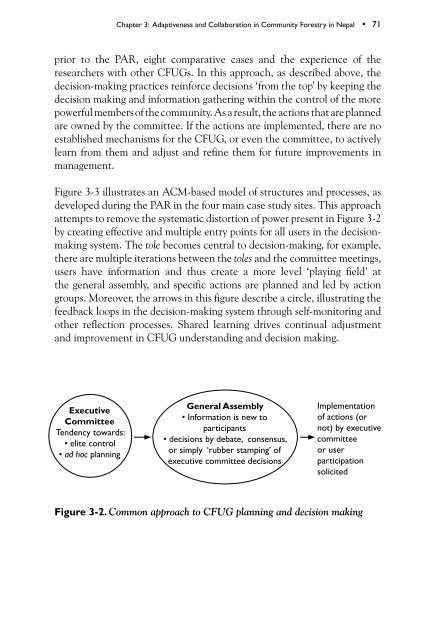Adaptive collaborative management of community forests in Asia ...
Adaptive collaborative management of community forests in Asia ...
Adaptive collaborative management of community forests in Asia ...
You also want an ePaper? Increase the reach of your titles
YUMPU automatically turns print PDFs into web optimized ePapers that Google loves.
Chapter 3: <strong>Adaptive</strong>ness and Collaboration <strong>in</strong> Community Forestry <strong>in</strong> Nepal • 71<br />
prior to the PAR, eight comparative cases and the experience <strong>of</strong> the<br />
researchers with other CFUGs. In this approach, as described above, the<br />
decision-mak<strong>in</strong>g practices re<strong>in</strong>force decisions ‘from the top’ by keep<strong>in</strong>g the<br />
decision mak<strong>in</strong>g and <strong>in</strong>formation gather<strong>in</strong>g with<strong>in</strong> the control <strong>of</strong> the more<br />
powerful members <strong>of</strong> the <strong>community</strong>. As a result, the actions that are planned<br />
are owned by the committee. If the actions are implemented, there are no<br />
established mechanisms for the CFUG, or even the committee, to actively<br />
learn from them and adjust and ref<strong>in</strong>e them for future improvements <strong>in</strong><br />
<strong>management</strong>.<br />
Figure 3-3 illustrates an ACM-based model <strong>of</strong> structures and processes, as<br />
developed dur<strong>in</strong>g the PAR <strong>in</strong> the four ma<strong>in</strong> case study sites. This approach<br />
attempts to remove the systematic distortion <strong>of</strong> power present <strong>in</strong> Figure 3-2<br />
by creat<strong>in</strong>g effective and multiple entry po<strong>in</strong>ts for all users <strong>in</strong> the decisionmak<strong>in</strong>g<br />
system. The tole becomes central to decision-mak<strong>in</strong>g, for example,<br />
there are multiple iterations between the toles and the committee meet<strong>in</strong>gs,<br />
users have <strong>in</strong>formation and thus create a more level ‘play<strong>in</strong>g field’ at<br />
the general assembly, and specific actions are planned and led by action<br />
groups. Moreover, the arrows <strong>in</strong> this figure describe a circle, illustrat<strong>in</strong>g the<br />
feedback loops <strong>in</strong> the decision-mak<strong>in</strong>g system through self-monitor<strong>in</strong>g and<br />
other reflection processes. Shared learn<strong>in</strong>g drives cont<strong>in</strong>ual adjustment<br />
and improvement <strong>in</strong> CFUG understand<strong>in</strong>g and decision mak<strong>in</strong>g.<br />
Executive<br />
Committee<br />
Tendency towards:<br />
• elite control<br />
• ad hoc plann<strong>in</strong>g<br />
General Assembly<br />
• Information is new to<br />
participants<br />
• decisions by debate, consensus,<br />
or simply ‘rubber stamp<strong>in</strong>g’ <strong>of</strong><br />
executive committee decisions<br />
Implementation<br />
<strong>of</strong> actions (or<br />
not) by executive<br />
committee<br />
or user<br />
participation<br />
solicited<br />
Figure 3-2. Common approach to CFUG plann<strong>in</strong>g and decision mak<strong>in</strong>g
















